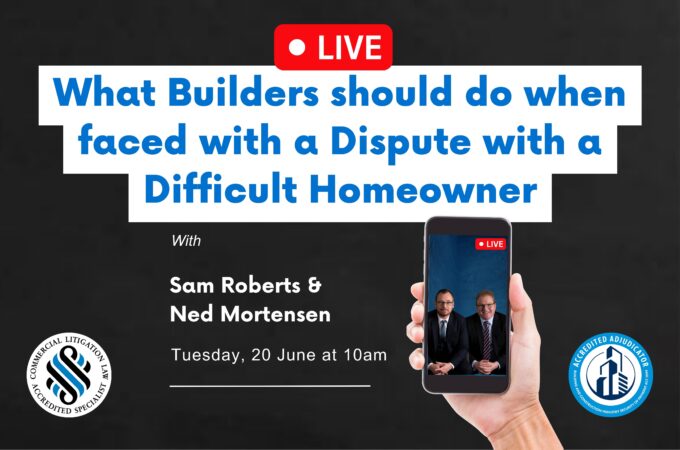This article will be particularly relevant for growing contracting businesses who are stepping up into the world of mid tier contracting, as I often see these types of companies make fundamental contract management mistakes with potentially disastrous consequences. These clients typically appear at our firm for help at the 11th hour of an ugly dispute, having previously had little regard for the contents of their Construction Contract, but hoping to rely on it now as their savior.
Mid Tier Construction Contracting Essentials
How to make it and not go broke!

Contractors whose businesses are growing often get themselves in trouble by signing a contract put forward by the other party without understanding their rights and obligations or properly considering the terms of the contract at all. This is especially so for long form Construction Contracts that incorporate Australian Standard General Conditions of Contract. These terms are often confusing and difficult for Contract Administrators to properly follow and administer. Because of this, works under these contracts are frequently performed without regard to the actual agreed terms, which of course is a recipe for disaster when problems arise.
This is a common mistake that often leads to a contractor’s failure to apply for adequate Extensions of Time (EOT) in accordance with the contract. Typically there are strict time limits for EOT claims and this failure may ultimately result in claims for liquidated damages against the contractor by the Head Contractor or Principal.
Most construction contracts require written notice to be given in the events of delay or changes to the scope of work which may give rise to a contractual variation. Failing to issue such notices in the way called by the contract can leave you in a position at the end of the contract where you are unable to claim for variations because they have not been approved or run the risk of liquidated damages due to a failure to apply for extensions of time.
Defects are one of the major causes of construction litigation that I see. If you are sued for the repair of faults which reveal themselves after the defects liability period, not only may you end up paying the cost of the additional works for which you should not be liable, but you could also be left paying the costs of defending the claim even when your defence is successful.
Exposure to claims for defect rectification can be minimised by taking the time to understand the defects liability period and the process by which defects need to be notified and rectified. The use of defect repair systems and checklists are essential. When claims are made by property owners after the conclusion of the defects liability period, get the right legal advice as to your contractual liability as soon as possible.
Recommendations
The following recommendations come from both construction industry and legal practice experience and can be adapted to both the management of Head Contracts and Subcontracts alike.
Tip 1 – Ignore the contract at your peril.
The right contract can be both a valuable weapon and a protector. If you’re a growing construction company stepping up into the mid tier market, be aware that your contract management game needs to change. Effective contract administration will work to maximise your profits and protect you from disaster. Similarly, a failure to fulfil your contractual administration obligations can have dire legal consequences in the event of any future dispute.
In particular, contractors should ensure that they are familiar with contract provisions relating to the correct ways to:
- give notices pursuant to the contract,
- apply for extensions of time,
- inform clients of variations and seek approval, where necessary,
- submit progress claims, and
- manage disputes.
Tip 2 – Get specialist legal advice prior to signing a contract.
If you’re signing a Construction Contract for an amount that you couldn’t afford to lose, having a Construction Lawyer explain the finer details and provide their feedback on the contract can be a very valuable investment. A Construction Lawyer can also recommend amendments to any contracts provided by Head Contractors and Principals to help ensure that there is a more level playing field between the parties, and even negotiate those amendments on your behalf.
Tip 3 – Develop your own plain English Construction Contract.
Construction Contracts incorporating Australian Standard General Conditions of Contract can be difficult to follow and administer unless you are an experienced Lawyer. Often these forms of contract are adopted by Principals or Head Contractors simply because they do not know what else to use or simply want to look like they know what they are doing. In most cases, however, a customised plain English Construction Contract would be of far greater use to all parties.
When the form of contract is not being put forward by a Principal or Head Contractor, I encourage contractors to develop and use a customised plain English long form Construction Contract with an accompanying Contract Matrix (see below). I have many clients that do this successfully, usually with the other party being grateful to receive something that is easier to understand and follow.
Tip 4 – Develop a Contract Matrix.
A Contract Matrix is a list of important contractual events, with a “how-to” guide for each. For example, the list might include:
- the commencement of site works,
- the discovery of latent conditions,
- dealing with requests for variations or change to the works required,
- the encountering of events causing delays,
- applying for extensions of time,
- when and how formal notices under the contract should be given,
- the making of progress claims,
- steps for practical completion and certification, and
- dealing with disputes.
Alongside each of these events should be step-by-step procedures covering off your contractual obligations for dealing with these events as they arise, and detailing any applicable time limitations.
A good Contract Matrix is written in simple, plain language and can even be in the form of a flowchart.
Tip 5 – Develop a set of Pro forma Contract Notices and Variation Forms.
Prepare templates for contract Notices and Variations so that they are quick and easy to issue. These should be checked (or prepared) by a Construction Lawyer. Consistently worded Notices that are familiar to both you and your client will go a long way to streamlining approvals and fast client responses.
Make sure that they are worded specifically for the contract you are using, and save them with any fields that need to be manually filled brightly highlighted.
Tip 6 – Have the right Administrator.
Have the contract administration process managed by an appropriate person in your organisation.
I often see growing construction companies leaving their contract administration to engineering and construction management graduates fresh from University. These young men and women can be an excellent choice, provided that they have the right support through specific training and management, and that they have both the authority and people skills to manage potential contractual problems when they arise.
For example, does the 23 year old, wet behind the ears Contract Administrator in your business have the wear with all and authority to stop the hardened 60 year old general foreman from using his two available 30 tonne excavators to excavate in rock he’s just discovered when the client hasn’t approved a variation for rock excavation?
The right support from both the Project Manager and company directors for fresh faced Contract Administrators is essential.
Tip 7 – When a problem arises get help early.
Form a relationship with a good Construction Lawyer and get the help that you need promptly, when you need it.
With most building disputes it is important to seek advice from an experienced Construction Lawyer as soon as it appears likely that a problem will arise. This will give you the best chance of avoiding a dispute and/or managing the problem before it grows into something bigger and ends in litigation.
Building and Construction Lawyers for Sydney and Newcastle
Need Answers Fast? Contact Us Today
The information in this article is not legal advice and is intended to provide commentary and general information only. It should not be relied upon or used as a definitive or complete statement of the relevant law. You should obtain formal legal advice specific to your particular circumstance. Liability limited by a scheme approved under Professional Standards Legislation.


























